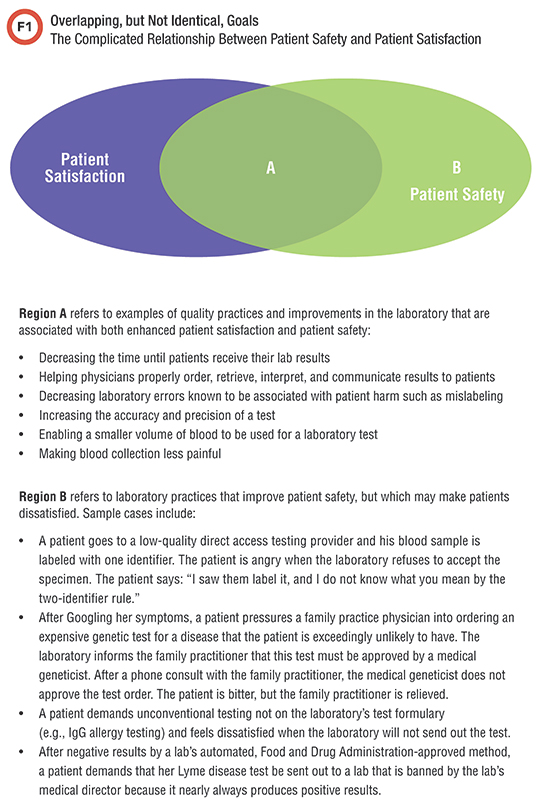I work in a hospital lab, and the hospital has goals for both patient satisfaction and patient safety. I am finding that these are sometimes in conflict, but my boss told me that they don’t have to be. Is my boss right or wrong?
Your boss is right and wrong. Patient satisfaction and patient safety do not have to be in conflict, but when they are, resolution is challenging.
The Agency for Healthcare Research and Quality defines patient safety as “freedom from accidental or preventable injuries produced by medical care” (1). In this definition, patient safety is considered a characteristic of healthcare institutions seeking to eliminate harm caused by medical care. Despite this noble aim, however, patient safety as an organizational goal can still conflict with other organizational objectives such as risk management, patient satisfaction, employee engagement, fiscal responsibility, client satisfaction (e.g., physicians in laboratory outreach), and environmental stewardship.
In a series of talks to laboratory outreach directors 10 years ago, I outlined the conflicts between client satisfaction and patient safety. For example, some physicians were unhappy when laboratories forbade relabeling a mislabeled specimen, even though a restrictive specimen relabeling policy is a quintessential part of patient safety. Similarly, some physicians were unhappy when they could no longer order some of their favorite tests, which had become obsolete because they were replaced by better tests. When client satisfaction and patient safety did not align, conflicts arose between clients and laboratory quality managers, as well as between laboratory sales staff and quality managers.
Satisfaction Versus Safety
The relationship between patient satisfaction and patient safety can be even more complicated than the lab’s relationship with physicians (Figure 1). Patient satisfaction itself has become a moving tar-get complicated by several interrelated trends: the Googlefication of healthcare, the direct-to-consumer healthcare movement, the amplification of both information and misinformation through social media, and the emphasis by healthcare organizations on patient experience.

Considered the basis of patient satisfaction, patient experience is defined as “the sum of all inter-actions, shaped by an organization’s culture, that influence patient perceptions across the continuum of care” (2). The desire to enhance patient experience can be challenging when some direct their own healthcare in ways that clash with organizational goals.
Resolving Conflicts
Rarely do conflicts between patient safety and patient satisfaction have easy answers. However, both care providers and laboratory staff can find a way forward by empathizing with patients and ex-plaining that their healthcare facility is patient-centered, but not patient-directed when it comes to clinical laboratory services. Many times a sincere, judgment-free, fact-based conversation leads to a reasonable result. At the end of the day, when a conflict arises between patient safety and patient satisfaction, patient safety must remain paramount.
Michael Astion, MD, PhD, is the editor-in-chief of CLN’s Patient Safety Focus, clinical professor of laboratory medicine at the University of Washington department of laboratory medicine, and medical director of the department of laboratories, Seattle Children’s Hospital. +Email: [email protected]
References
- Agency for Healthcare Research and Quality. Patient safety network glossary. https://psnet.ahrq.gov/glossary/p (Accessed November 20, 2017).
- The Beryl Institute. Defining patient experience. http://www.theberylinstitute.org/?page=definingpatientexp (Accessed November 20, 2017).
CLN's Patient Safety Focus is supported by ARUP Laboratories
